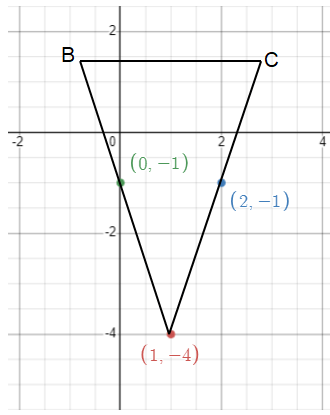AREA OF TRIANGLE WITH COORDINATES
The area of a triangle with vertices A(x1, y1), B(x2, y2) and C(x3, y3)
Problem 1 :
Find the area of the triangle ABC with A(1, -4) and the mid-points of sides through A being (2, -1) and (0, -1).
Solution :
The coordinates of the mid point of the line segment joining the points P(x1, y1) and Q(x2, y2) are

Given, the midpoint A(1, -4) and (x, y) is (2, -1)
|
(1 + x)/2 = 2 1 + x = 4 x = 4 - 1 x = 3 |
(y - 4)/2 = -1 y - 4 = -2 y = -2 + 4 y = 2 |
The coordinates of B is (3, 2).
Given, the midpoint of A(1, -4) and C(a, b) is (0, -1).
|
(1 + a)/2 = 0 1 + a = 0 a = -1 |
(-4 + b)/2 = -1 b - 4 = -2 b = -2 + 4 b = 2 |
The coordinates of C are (-1, 2).
The area of a triangle with vertices A(x1, y1), B(x2, y2) and C(x3, y3)
The area of a triangle with vertices A(1, -4), B(3, 2) and C(-1, 2)
Therefore, the area of the triangle ABC is 12 square units.
Problem 2 :
Find the value of m if the points (5, 1), (-2, -3) and (8, 2m) are collinear.
Solution:
Points A, B, C will be collinear if the area of ΔABC = 0
Hence, the required value of m = 19/14.
Problem 3 :
Find the area of the triangle whose vertices are (-8, 4), (-6, 6) and (-3, 9)
Solution:
Let the vertices of triangle be,
A(x1, y1) = (-8, 4) B(x2, y2) = (-6, 6) and C(x3, y3) = (-3, 9)
Hence, area of the triangle with vertices (-8, 4), (-6, 6) and (-3, 9) is 0 square units.
Problem 4 :
The points A(2, 9), B(a, 5) and C(5, 5) are the vertices of a triangle ABC right angles at B. Find the values of a and hence the area of ΔABC.
Solution:
Given, the points A(2, 9), B(a, 5) and C(5, 5) are the vertices of right angle triangle whose angle B is right angle.
By distance formula,
AB2 + BC2 = CA2
Put first a = 2, In AB, BC and CA
Then,
Now, put a = 5 and we get,
Then a = 5 is not possible.
Hence a = 2 is possible for all value of right angle triangle.
Area of the right angles triangle ABC is
Problem 4 :
A(6, 1), B(8, 2) and C(9, 4) are three vertices of a parallelogram ABCD. If E is the midpoint of DC, find the area of ΔADE.
Solution:
Let fourth vertex of ABCD be D(x, y). We know that, the diagonals of a parallelogram bisects each other.
Mid point of BD = Mid point of AC
Thus, the required fourth vertex D is (7, 3).
Now, midpoint of DC
Area of ΔADE with vertices A(6, 1), D(7, 3) and E(8,7/2) is
Hence, the area of ΔADE is 3/4 square units.
Recent Articles
-
Finding Range of Values Inequality Problems
May 21, 24 08:51 PM
Finding Range of Values Inequality Problems -
Solving Two Step Inequality Word Problems
May 21, 24 08:51 AM
Solving Two Step Inequality Word Problems -
Exponential Function Context and Data Modeling
May 20, 24 10:45 PM
Exponential Function Context and Data Modeling